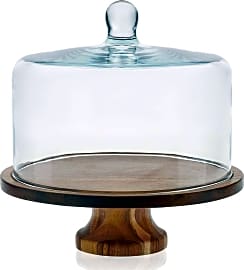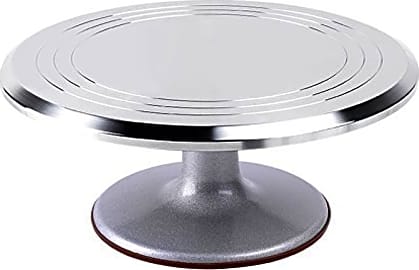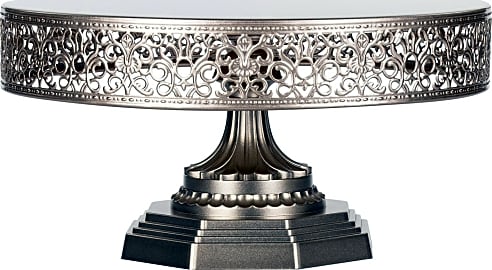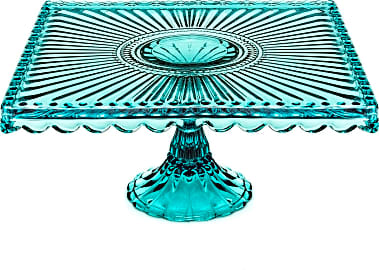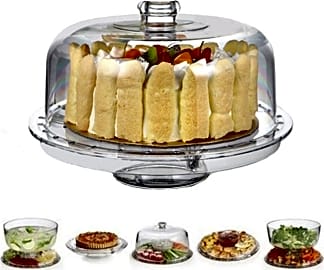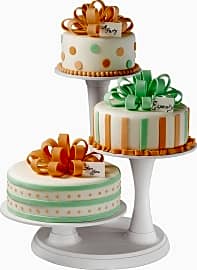The 10 Best Cake Stands

This wiki has been updated 34 times since it was first published in October of 2016. If you're planning on serving an impressive dessert, it should be displayed on an equally impressive platform. These cake stands come in a variety of materials and designs that will enhance any occasion, and some feature turntables that make it easy to decorate your sweets and show them off from any angle. We've included options for everyone from home bakers to professionals. When users buy our independently chosen editorial choices, we may earn commissions to help fund the Wiki.
Editor's Notes
February 01, 2021:
We removed the Libbey Acacia Wood due to quality concerns. We added more glass options to the list, since glass is an aesthetically pleasing material that is also relatively easy to clean and can withstand moisture well. When choosing a stand, keep in mind how you're going to use it. Some are better suited to the decorating process while others are best for display. Some are versatile enough to serve both purposes well.
November 27, 2019:
When settled next to a tiered cupcake display and elegant serving set, the right cake stand can add an extra special touch to a wedding, baby shower, birthday, office party, bridal shower, and much more. In addition to being wonderful for serving and display, they are also helpful for transport, and rotating models aide bakers with frosting sides, piping borders, decorating tops, and leveling their cakes as well.
In this vein, any baker would love to have the Wilton High and Low, Ohuhu Revolving, or Ateco Aluminum in their arsenal. If you're looking for something pleasing simply for display, then the Amalfi Decor Anastasia and Amalfi Decor Victoria are perfect for weddings, while the rustic Libbey Acacia Wood and classic Ateco Aluminum are great for less formal events like birthdays and office potlucks. The Mosser Jadeite is ideal for baby showers and display cases in bakeries, thanks to its Pinterest-worthy design, lovely light color, and photogenic qualities.
Today we said goodbye to the Dahlia Studios and Wilton Trim 'n Turn due to availability concerns, and replaced them with the equally compelling Wilton High and Low and understated Libbey Acacia Wood. We also swapped the Ateco Aluminum for its updated iteration, which has been made more durable than the previous.
Special Honors
Butterfly Ginkgo From award-winning American artist Michael Aram comes the handmade Butterfly Ginkgo cake stand. Inspired by the Ginkgo biloba tree, it is skillfully crafted from solid bronze with acid etched cocoon-shaped vessels, topped with golden butterflies, and finished with a solid marble plate. michaelaram.com
Standing Tall And Delicious
A single-tiered stand might be be used for a family get-together for Thanksgiving, setting it apart from all the other food items spread out across a dining room table.
When visiting my local grocery store, I'll admit to having my curiosity piqued and my taste buds stimulated by the sights and smells of freshly-baked sweets, regardless of whether they're presented from inside a refrigerated display case or sitting on the shelves waiting to be purchased. But setting an attractive stage for the presentation of food only serves to heighten my level of anticipation for enjoying it. Party guests will experience a similar feeling when they see a beautiful cake just waiting to be devoured on a table. If you plan to show off a cake as the main centerpiece for your guests to enjoy at a particular venue, you'll need a dependable stand to support it and set it apart from all the other items on display.
In the most fundamental sense, a cake stand is a small (typically circular) platform on which a cake is placed and displayed. While there are many different styles and methods by which to prepare and decorate this confection, the simple act of elevating the treat adds to its beauty, while simultaneously setting it apart from other items on the table. The wedding cake, for example, is considered front and center during the reception following the ceremony. It is synonymous with good fortune, fertility, and social status among other attributes. Therefore, its method of display is just as important as its flavor and how it will be consumed.
Cake stands are categorized by the number of tiers and/or by the materials from which they're constructed. A single-tiered stand might be be used for a family get-together for Thanksgiving, setting it apart from all the other food items spread out across a dining room table. More elaborately-tiered cakes for weddings, special occasions, and large office parties will have two, three, or more tiers. In addition to the presentation appeal, tiering is also used to mark accomplishments and to celebrate specific achievements.
Common construction materials for cake stands include wrought iron, glass, ceramic, porcelain, and metal, many of which are durable and relatively easy to maintain. Iron and metal cake stands are on the heavy end of the spectrum and fashioned with decorative shapes and other designs to increase their aesthetic appeal on a table's surface. Their extra weight also makes them a good choice for supporting multi-tiered cakes. By contrast, glass stands provide a blank canvas for a cake, making them a great option for particularly colorful confections with dense ingredients (e.g. single-tier coffee or chocolate cakes). Some glass stands also come with domed lids to keep the food protected while sitting on a table for extended periods of time prior to serving. Porcelain and ceramic stands are a bit more fragile than their glass and metal counterparts, but are ideal for decorative purposes.
A Stable Platform For Your Confection
Like many accessories, the choice of cake stand is dependent on a variety of factors, including the environment in which it's placed, the occasion, and the type of flavor of the food being served. That said, there are several practical considerations you should keep in mind. The stand should be heavy enough to support your cake and the number of tiers in its design. Iron and metal stands are durable enough to support multiple tiers and come highly-recommended for such scenarios.
Overall presentation is an important part of your decision. Although a cake's main purpose is for it to be enjoyed by family, friends, and colleagues, there's certainly nothing wrong with establishing a fanciful display to wow your guests upon their arrival, regardless of the type of venue or special occasion taking place. If nothing else, your stand should elicit a sense of pride and happy celebration. Consider investing in a revolving stand, as this type of platform not only provides easy access to the cake when you need to apply frosting, but your guests will also be able to view the food from any angle without having to walk around the table.
Color choice makes a significant impact, depending on the type of event. For example, bold choices like pinks, blues, and greens easily stand out at themed wedding receptions or baby showers, whereas neutral colors (like white) are ideal for office gatherings, holiday parties, graduations, and other formal social gatherings.
A Brief History Of Cake Stands
The culture of Ancient Egypt was the first to show true skill in terms of baking in large quantities. This is found in evidence of bread sweetened with honey, which was considered one of the most rudimentary forms of the "cake". Early cakes didn't resemble what we now consider the sweet and round confection by today's standards. The ancient Romans also used a bread dough enriched with butter, eggs, and honey to make a sweet and cake-like creation.
The first cake stands appeared during the late Victorian period in the latter part of the 19th century.
The precursor to the modern cake was first baked in Europe during the mid-17th century, thanks to advances in both oven technology and the manufacturing of food molds. Cakes of this style were both round and flat in shape and turned over at least once during the baking process. The modern cake (as we know it today) appeared by the middle of the 19th century and was made with extra refined white flour and baking powder instead of yeast.
The first cake stands appeared during the late Victorian period in the latter part of the 19th century. This was during the same time that afternoon tea ceremonies became a popular daily ritual. By elevating cakes above other types of food on a serving table, these stands provided an additional platform and "stage" for onlookers, setting them apart from the other comestibles.
Modern cake stands are found in numerous colors, patterns, and materials that suit a variety of environments, bringing a sense of completion to the theme and ambiance of almost any type of social gathering.



